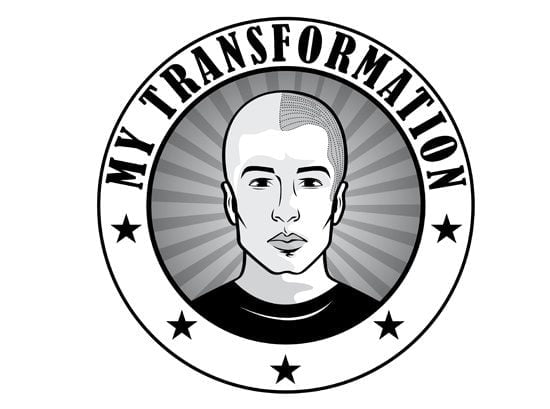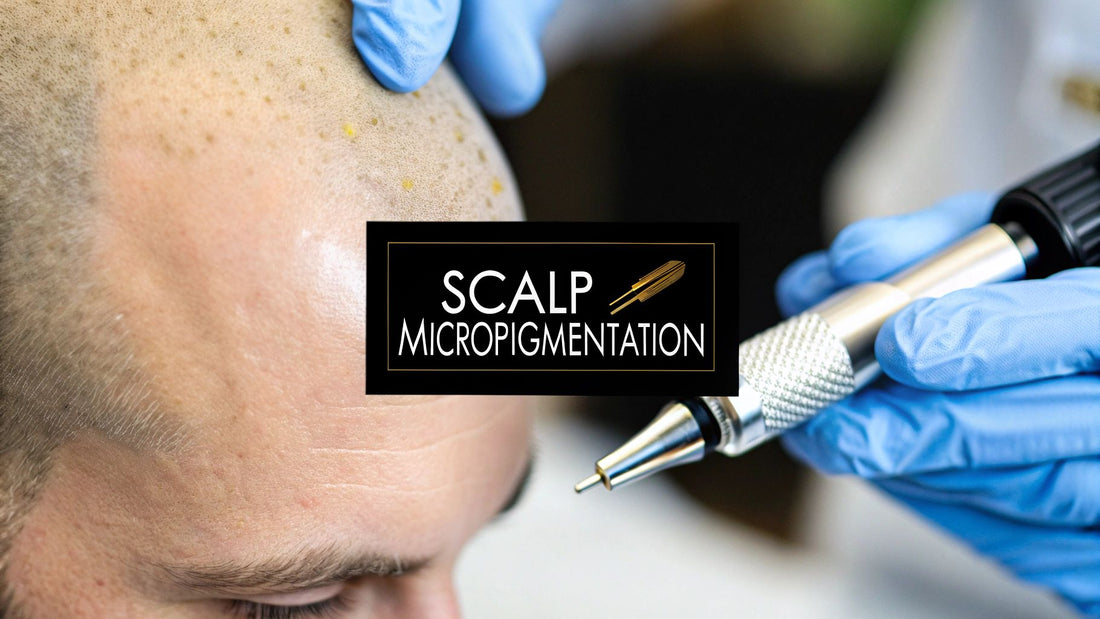
Scalp Micropigmentation A Hair Loss Solution
Share
Scalp micropigmentation, often shortened to SMP, is a highly advanced cosmetic procedure that brilliantly mimics the look of real hair follicles. Think of it less like a traditional tattoo and more like a permanent, non-surgical solution for hair loss, creating the illusion of a full head of hair or adding density to thinning areas.
Understanding Scalp Micropigmentation
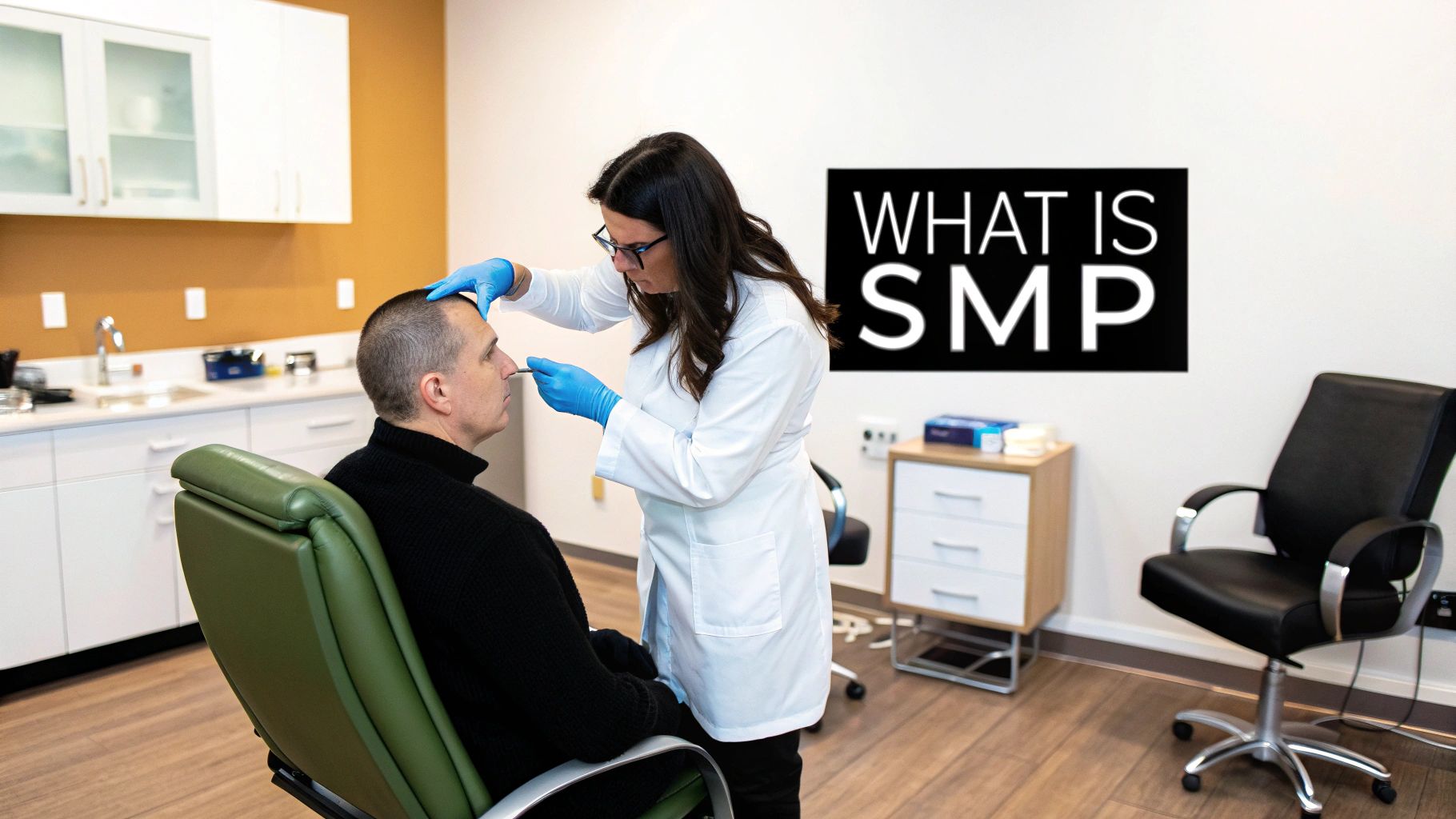
The best way to picture how SMP works is to think of pointillism, the art technique where artists create a complete image from thousands of tiny, individual dots. SMP applies that same idea to your scalp. A trained specialist uses purpose-built equipment to carefully deposit micro-dots of pigment just beneath the skin's surface.
But this isn't random dotting. It’s a meticulous, artistic process. Each impression is strategically placed to replicate the exact size, angle, and shading of a natural hair follicle. For someone with significant balding, this masterfully creates the look of a sharp, modern buzz cut. For those with thinning hair, it works by reducing the noticeable contrast between the scalp and hair, giving an immediate look of thicker, denser hair.
More Than Just a Tattoo
It's a common misconception to lump SMP in with regular body tattoos. While they both use needles and pigment, that’s where the similarities end. The equipment, pigments, and techniques are worlds apart and specifically designed for the delicate skin on the scalp.
Here’s what makes SMP unique:
- Specialised Pigments: The pigments used are formulated to match natural hair colours. Crucially, they’re designed to be stable, so they won't fade to strange blue or green shades over time like some tattoo inks can.
- Unique Technique: An SMP artist uses a much lighter touch, depositing the pigment into the upper dermis. This shallow placement is key to keeping the dots crisp and defined, preventing them from blurring into one another.
- Purpose-Built Tools: The needles are incredibly fine, much smaller than those used for body art. This allows the technician to create tiny follicle replications that are genuinely convincing up close.
Getting these details right is what separates a natural-looking result from an obvious one. You can dive deeper into the technical side of things in our guide on how SMP works for hair loss.
At its core, scalp micropigmentation is an art form that blends technical skill with a deep understanding of aesthetics. It’s about restoring not just a hairline, but also the confidence that often disappears with hair loss.
A Non-Surgical Solution
Perhaps one of the biggest draws of SMP is that it’s completely non-invasive. Unlike hair transplant surgery, there are no scalpels, no stitches, and no long, painful recovery. Most clients are back to their regular routine within a couple of days.
This makes it a fantastic choice for anyone looking for a powerful and immediate result without the risks, downtime, and commitment of surgery. By creating a flawless simulation of hair, SMP delivers a practical and incredibly effective way to take control of hair loss.
Is Scalp Micropigmentation Right for You?
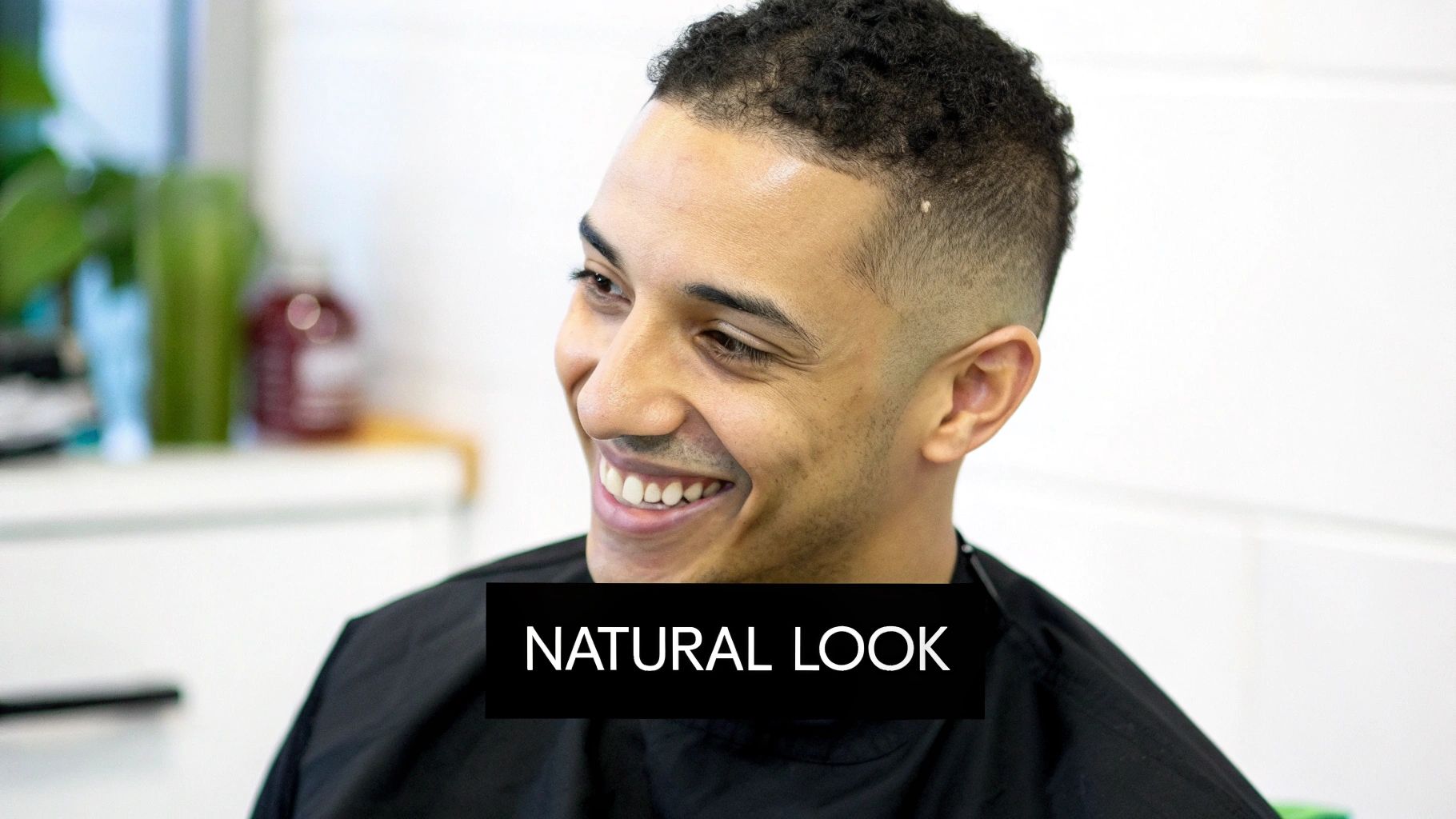
Choosing how to tackle hair loss is a big decision, and scalp micropigmentation is a genuinely powerful option for many people. But is it the right move for your specific situation? The great thing about this technique is its versatility—it can effectively address a whole range of hair loss scenarios.
From men dealing with pattern baldness to women experiencing thinning hair, SMP offers a dependable way to bring back the look of fullness. It’s also brilliant for camouflaging scars from accidents or old hair transplant surgeries, making them blend seamlessly into the scalp.
The real key is figuring out who makes a great candidate and what you can realistically expect.
Creating the Perfect Buzz Cut Look
For guys with more advanced hair loss—think a receding hairline or significant balding on the crown—SMP is a total game-changer. The treatment is masterful at creating the look of a full head of hair that’s been shaved down. Picture it as a permanent five-o'clock shadow for your scalp.
This is the perfect solution for anyone who:
- Already rocks a shaved head or is ready to embrace a sharp, clean buzz cut style.
- Wants to frame their face again with a crisp, well-defined hairline.
- Is after a low-maintenance fix that doesn’t involve any styling products or complicated routines.
The final result is a sharp, polished appearance that looks clean and intentional, not like you're losing your hair. It brings back that strong, youthful frame to your face.
Adding Density to Thinning Hair
You don’t have to be completely bald to get a massive confidence boost from SMP. For both men and women who are noticing their hair is becoming less dense all over (diffuse thinning), this treatment can work wonders.
In this case, the practitioner carefully applies pigment between your existing hair strands. This simple step reduces the harsh contrast between your hair colour and the lighter tone of your scalp. By strategically darkening the skin underneath, SMP creates a clever optical illusion of thickness, making your hair look much denser and fuller.
Think of SMP for density like using a dark primer on a canvas. It establishes a base shadow that makes the final artwork—your hair—appear richer and more substantial, hiding those areas where the scalp peeks through.
This approach is incredibly effective for anyone with enough hair left to provide texture. The SMP then acts as a permanent, waterproof concealer. It's a subtle change with a huge impact.
Camouflaging Scars and Imperfections
Scars on the scalp can be a real source of frustration, especially those left from injuries or older hair transplant methods like FUT (the "strip" method). Scalp micropigmentation is exceptionally good at making these imperfections fade into the background.
A skilled artist will meticulously place pigment deposits on and around the scar tissue. This technique breaks up the solid line of the scar and helps it blend in with the thousands of replicated follicles nearby. It makes the scar far less obvious, giving you the freedom to wear your hair short without a second thought. This kind of camouflage work is just one of many ways people can benefit from hair tattoos and get their confidence back.
When SMP Might Not Be the Best Choice
While SMP is incredibly adaptable, it's not a silver bullet for every single person. It’s vital to have honest conversations and realistic expectations to make sure you'll be happy with the outcome.
It might be worth exploring other avenues if:
- You have large bald areas but want long hair: If you're hoping to keep your remaining hair long, SMP on a large bald patch can look a bit off. The contrast between the flat, 2D illusion of SMP and the texture of your real hair can be quite noticeable.
- You have active scalp conditions: Problems like severe psoriasis, dermatitis, or widespread scalp acne need to be properly managed first. Treating inflamed or irritated skin is a bad idea, as the pigment just won't settle correctly.
- Your expectations are a bit off the mark: It’s crucial to remember that SMP creates the appearance of hair follicles. It doesn't grow hair, nor does it have the three-dimensional texture of real hair. Understanding this from the get-go is the secret to being thrilled with your results.
The SMP Journey: From Consultation to Completion
Thinking about scalp micropigmentation is exciting, but it’s natural to wonder what the whole process actually involves. From start to finish, it's a carefully planned partnership between you and your specialist, designed to craft a result that looks completely natural and is customised just for you. This isn’t just about applying pigment; it’s a multi-stage process where artistry and precision come together.
The treatment is never rushed. It’s deliberately broken down into several stages, each with its own purpose. This step-by-step approach allows us to build up the final look gradually, which is the secret to achieving that incredibly subtle, realistic finish that blends in perfectly.
This infographic gives you a bird's-eye view of the core stages, from that first chat all the way to the final result.
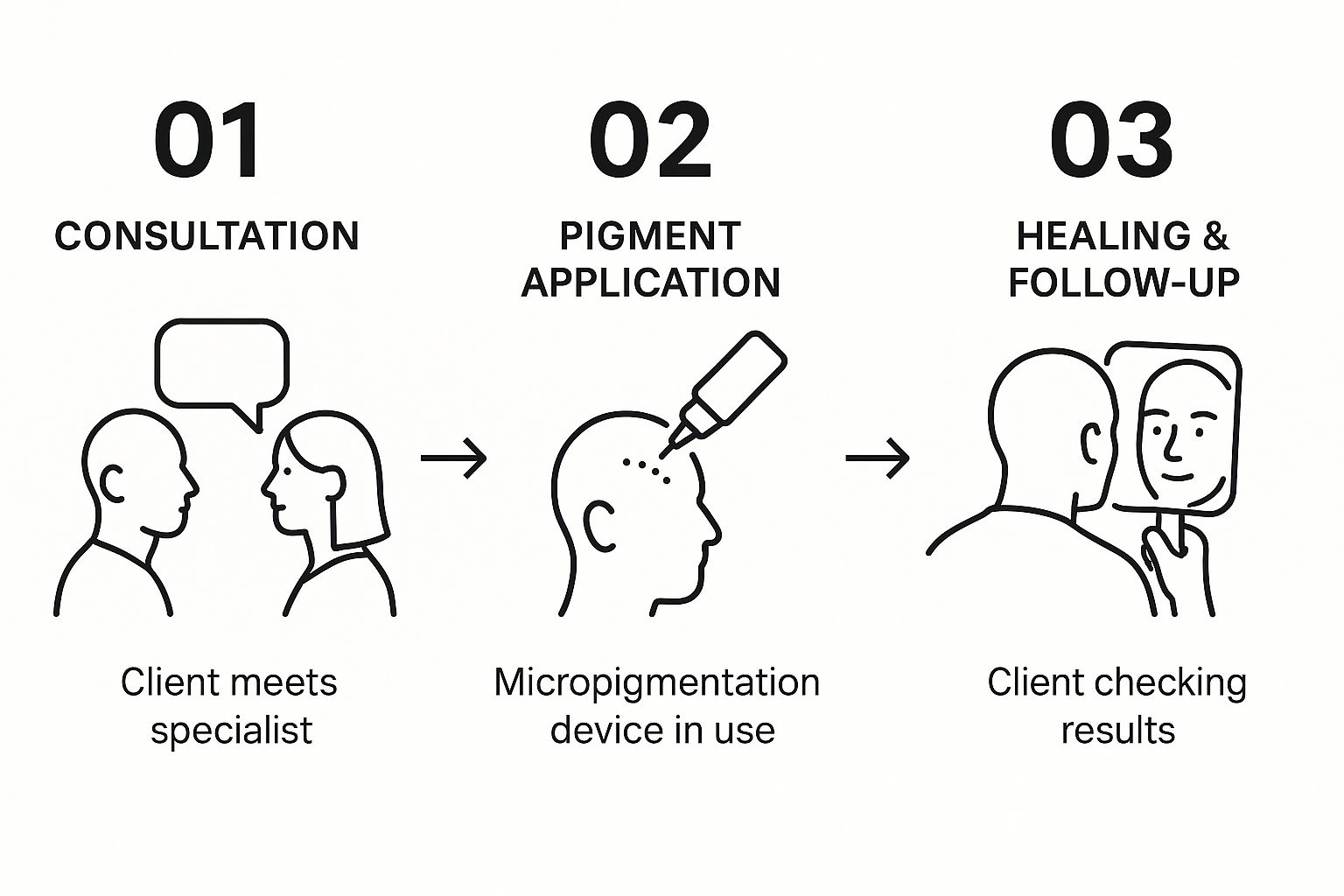
As you can see, it's a structured journey that depends on expert skill and proper client care to get it right.
Step 1: Your Initial Consultation
The first step is arguably the most important one: the consultation. This is where you and an SMP specialist sit down to map out exactly what you want to achieve. Think of it as a strategy session—it's your chance to ask every question you have, and it allows the practitioner to properly assess your scalp and hair loss pattern.
During this meeting, we’ll nail down a few key things:
- Hairline Design: Together, we'll design your perfect hairline. We’ll look at your face shape, your age, and your personal style to create something that’s not just flattering but also looks totally believable.
- Pigment Matching: Your specialist will meticulously select a pigment shade that’s a perfect match for your natural hair colour and skin tone. Getting this right is crucial for making the final result undetectable.
- Treatment Plan: Based on your level of hair loss, you’ll get a clear plan that outlines the estimated number of sessions needed and what will happen in each one.
This first meeting really sets the stage for everything else, making sure everyone is on the same page about the final goal.
Step 2: The Treatment Sessions
Once the plan is locked in, it’s time for the treatment itself. A full scalp micropigmentation procedure is typically done over 2-4 sessions, with each one lasting a few hours. This multi-session approach is non-negotiable for getting a natural look. Trying to cram it all into one sitting would leave you with a flat, "filled-in" look that screams fake.
Instead, we build density layer by layer. The first session creates the foundational hairline and a light scattering of follicle impressions. In the following sessions, we add more impressions, creating subtle layers of tone that mimic the three-dimensional appearance of real hair follicles.
It helps to think of it like an artist painting a canvas. The first coat blocks in the basic colour, but it’s the additional layers that add depth, shadows, and fine details to make the image come alive. SMP works the exact same way to build realistic density.
You’ll need about 10-14 days of healing time between sessions. This break is vital—it lets the pigment settle into your skin and gives the artist a clear picture of how the colour is holding, so they know exactly what’s needed in the next session to perfect the look.
Step 3: Healing And Aftercare
After your final session is done, the focus shifts to aftercare. The healing process is pretty straightforward, but following the rules is the best way to protect your investment. Your practitioner will give you specific instructions, but the golden rules are simple.
For the first few days, you'll need to steer clear of:
- Getting your scalp wet, which includes avoiding heavy sweating at the gym.
- Using any shampoos or harsh chemicals on the treated area.
- Exposing your scalp to intense, direct sunlight.
Following these guidelines ensures the pigment sets properly and the tiny impressions heal cleanly. To get a head start, our guide on how to prepare for scalp micropigmentation treatment covers all the essentials. Once you’re healed, the most important thing you can do for long-term results is to protect your scalp from the sun with a good, high-SPF sunscreen. It’s the key to keeping your SMP looking sharp for years to come.
The Real Cost of SMP in Australia

Let's get straight to it: when you're thinking about a life-changing procedure like scalp micropigmentation, the first question on your mind is probably, "How much will this set me back?" It's a fair question, and the answer isn't as simple as a price tag on a shelf.
Think of SMP less like a product and more like a custom-tailored suit. The final cost depends entirely on you—the extent of your hair loss, the result you're after, and the artistry required to get you there. It's a bespoke service, not a one-size-fits-all solution.
Because every client's scalp and hair loss pattern is unique, there’s no single price. Instead, the total investment is calculated based on a few key variables that determine the time and skill needed to create a seamless, natural look.
Key Factors That Determine Your SMP Price
The final figure on your SMP quote comes down to the amount of detail and coverage required. Someone just looking to add a bit of density to a thinning crown will naturally have a different price point than someone who needs a full replication of a new hairline from scratch.
Here’s what really shapes the cost:
- Extent of Hair Loss: This is the big one. We often use the Norwood scale to measure the stage of male pattern baldness, from minor recession (Stage 2) right through to extensive hair loss (Stage 7). The more scalp there is to cover, the more work, time, and pigment are involved.
- Number of Sessions: A proper SMP treatment isn't a one-and-done deal. It’s carefully layered over 2-4 sessions to build up realistic density and depth. How many you'll need depends on your skin type and the desired fullness.
- Practitioner Expertise: You're not just paying for ink and needles; you're paying for experience. A seasoned artist with a strong portfolio and a reputation for excellence will command a higher fee. It’s an investment in their skill, artistic eye, and the peace of mind that comes with proven results.
When you're budgeting for SMP, it helps to see it as a long-term investment in your confidence. The cost reflects the freedom from constantly worrying about hair loss and the daily convenience of a sharp, maintenance-free look.
Typical SMP Cost Ranges in Australia
While every treatment is customised, having a ballpark figure helps. In Australia, the cost for a complete SMP treatment generally starts from AUD $800 for minor work and can go up to AUD $4,000+ for clients needing extensive coverage.
To give you a clearer picture, here’s a breakdown of how pricing often aligns with the Norwood scale.
Estimated SMP Cost in Australia by Norwood Scale
| Norwood Stage | Description of Hair Loss | Estimated Cost Range (AUD) |
|---|---|---|
| Stage 2-3 | Minor hairline recession or thinning at the crown. | $800 - $1,800 |
| Stage 4-5 | Significant recession and a noticeable bald spot. | $1,800 - $2,800 |
| Stage 6-7 | Extensive hair loss with only a band of hair remaining. | $2,800 - $4,000+ |
These figures are a guide, and the final price will always depend on your specific needs, including blending into existing hair or camouflaging scars.
Why the Cheapest Option Is Rarely the Best
It can be tempting to hunt for a bargain, but with a permanent procedure like SMP, "cheap" can end up being very expensive. An unusually low price is often a red flag—it might signal an inexperienced technician, low-quality pigments, or rushed, sloppy work.
Fixing a botched SMP job is often more difficult and costly than getting it done right the first time. We explore this topic in more detail in our complete guide to scalp micropigmentation cost.
Ultimately, the price reflects the quality, safety, and artistry you receive. Investing in a skilled, reputable professional ensures you walk away with a natural, lasting result you’ll be proud to show off for years to come.
Benefits and Risks You Should Know
Deciding on scalp micropigmentation is a big step, so you need the full picture—the good and the not-so-good. Like any cosmetic treatment, SMP has some incredible benefits that can genuinely be life-changing. But it’s just as important to have your eyes open to the potential risks and what to consider for the long haul.
Weighing both sides is the only way to feel truly confident in your decision. Let's break down what makes SMP such a popular choice, then look at the potential downsides you need to be aware of.
The Major Advantages of SMP
One of the best things about scalp micropigmentation is how quickly you see results. You’re not waiting months for hair grafts to grow in like you would with a transplant. Instead, you walk out of your very first session already seeing a noticeable difference.
And for many people, the fact that it's a non-surgical approach is a huge relief.
- No Surgery, No Downtime: There are no scalpels, no stitches, and no long, drawn-out recovery. Most clients get back to their normal life within a day or two.
- Seriously Low Maintenance: Once the treatment has fully healed, there’s not much you need to do. A good sunscreen to protect the pigment from UV damage and a bit of moisturiser is all it takes to keep it looking fresh for years.
- A Massive Confidence Boost: This is probably the biggest benefit of all. Getting your hairline back can completely change how you feel about yourself and how you walk into a room.
Understanding the Potential Risks
While SMP is a very safe procedure when done right, it isn't completely without risk. The great news is that almost all potential problems come down to one thing: the skill of the practitioner. A poorly trained technician is the number one reason for unhappy clients.
An inexperienced artist can leave you with results that look anything but natural. Think:
- A hairline that's too sharp or doesn't suit the shape of your face.
- Pigment dots that are too big or placed too deep, which can cause them to blur into a 'smudge' over time.
- A pigment colour that's just a little bit 'off' from your natural hair and skin tone.
Your SMP should be so good that it's undetectable. The aim is for people to think you look great, not for them to spot you've had work done. This is why choosing the right artist is absolutely everything.
It's also worth thinking about skin sensitivities. Allergic reactions to modern SMP pigments are incredibly rare, but they can happen. Always chat with your specialist about any skin allergies you have. For a bit more context on this, guides on understanding hypoallergenic products can provide some useful background on being mindful of ingredients.
Long-Term Considerations and Industry Growth
It’s important to know that scalp micropigmentation isn't permanent—it's semi-permanent. The specialised pigments are designed to lighten and fade slowly over several years. This is actually a good thing, as it allows you to make adjustments as your look changes with age. However, it does mean that touch-up sessions are needed every 4-6 years to keep the colour and definition looking sharp.
The boom in SMP's popularity really speaks to how effective it is. The global scalp micropigmentation market was valued at around USD 1.21 billion in 2024 and is expected to keep growing. This trend, which we’re also seeing right here in Australia, shows that more and more people trust SMP as a real-world solution for hair loss. This rapid growth also means it's more important than ever to find a proven, established professional to make sure you get the best possible care and an amazing result.
Long Term Care for Your SMP
Think of your new scalp micropigmentation as a quality investment. And just like any good investment, a little bit of upkeep is needed to keep it looking its best for the long haul. Protecting your SMP right from the start is the secret to ensuring it stays sharp and undetectable for years to come.
The aftercare is surprisingly straightforward, focusing on two key phases: immediate healing and long-term maintenance.
For the first few days after your session, your scalp just needs a bit of time to heal properly. It's crucial to follow the specific advice your practitioner gives you. This usually involves keeping your scalp dry, avoiding heavy workouts that make you sweat, and staying away from shampoos or harsh products. This short, careful period is what allows the pigment to settle in perfectly.
Protecting Your Investment for Years
Once you're past that initial healing window, looking after your SMP becomes incredibly simple. The number one enemy of your new look? The sun. Over time, UV radiation can cause the specialised pigments to fade, much like a regular tattoo.
The good news is that protecting it is easy. Just make sun protection a non-negotiable part of your daily routine.
- Slap on a high-SPF sunscreen: Applying a sunscreen of SPF 30+ or higher to your scalp every single day is the best defence.
- Wear a hat: If you're planning a long day outdoors, a hat is your best friend. It provides a simple, effective physical barrier against the sun's rays.
These two simple habits are genuinely all it takes to preserve the colour and sharp detail of your treatment.
Moisturising and Touch-Ups
A healthy scalp is a happy scalp, and it's also the key to keeping your SMP looking crisp. When your skin is well-moisturised, the pigment simply looks better. A light, daily moisturiser will stop your scalp from getting dry and flaky, which keeps the tiny follicle replications looking defined.
Think of your scalp as the canvas for the SMP artwork. A healthy, hydrated canvas keeps the art looking vibrant. Dry, flaky skin, on the other hand, can blur the fine details.
Over a long period, you'll naturally see some very gradual lightening of the pigment. This is completely normal and expected. Most clients find they come back for a quick touch-up session every 4-6 years to restore that original depth and colour. It's a simple refresh that gets your look right back to day one.
For a more detailed guide, check out our 5 top tips to care for your scalp after SMP.
Still Have a Few Questions About Scalp Micropigmentation?
Even after getting a good handle on the what, why, and how of scalp micropigmentation, it’s only natural to have a few more questions rattling around. Making a decision like this is a big deal, and you deserve to have all the facts straight before you move forward.
Let’s be honest, most people are wondering about the same three things: does it hurt, how long does it really last, and will it look like the real deal up close? Let's get into it.
So, Does Scalp Micropigmentation Hurt?
This is usually the first question out of everyone’s mouth, and the answer is reassuring: it’s nowhere near as intense as a regular tattoo. Most of our clients describe it as a light, consistent prickling feeling—more of a minor annoyance than actual pain. On a scale from 1 to 10, the vast majority put it somewhere between a 2 and a 4.
Of course, a few things can affect what you feel:
- Where it's being done: The skin on the sides of your head (the temples) is a bit more sensitive than the top or the crown.
- Your own pain tolerance: Everyone's different, and what feels like a tickle to one person might be more noticeable to another.
- Numbing creams are an option: If you're worried about sensitivity, we can apply a topical numbing cream beforehand to take the edge off and make sure you're comfortable.
At the end of the day, any discomfort is short-lived and almost everyone finds it completely manageable.
Is SMP a Permanent Fix?
Think of scalp micropigmentation as a semi-permanent solution. The pigments we use are designed to last, but they will slowly lighten over several years. This happens for a couple of reasons, mainly sun exposure and the natural way your skin regenerates. But this is actually a good thing.
Your look will naturally change as you get older, and your hairline should evolve with you. Because SMP is semi-permanent, we can make small tweaks to the hairline or colour down the track, ensuring it always looks age-appropriate and natural.
Most people find their results stay looking crisp for 4-6 years before they feel the need for a quick touch-up. That session is just a simple refresh to bring back the original colour and definition, getting things looking sharp again.
Will It Look Fake When People Get Close?
When it’s done right by a true professional, scalp micropigmentation is practically invisible to the naked eye. The magic is in the detail and the skill of the artist.
A seasoned practitioner delivers a flawless result by:
- Custom-blending the pigment: They’ll mix a unique shade that perfectly matches your skin tone and any remaining hair.
- Building up density gradually: The look is created over several sessions, layering different tones to create the illusion of 3D depth, just like real hair.
- Mimicking nature: They use various needle sizes and pressures to recreate the slightly random, imperfect pattern of natural hair follicles. No two dots are exactly the same.
A rushed or inexperienced job can definitely look unnatural, which is why your choice of specialist is the most critical part of this whole process. A master artist's work just blends in, leaving people thinking you look fantastic, not wondering what you had done.
Ready to see how scalp micropigmentation can bring back your confidence? At My Transformation, we’re all about creating realistic results that change lives. Head online to book your free consultation and let's get your journey started at https://www.mytransformation.com.au.
